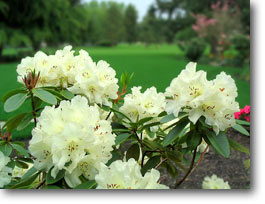 ...There's a Rhododendron in My Garden!
...There's a Rhododendron in My Garden!
A weed is a plant that has mastered every survival skill except for learning how to grow in rows. - Doug Larson
This is Oregon, after all. A yard without one would be un-northwestern, I think! I have a few Rhodys (as we north westerners affectionately refer to them) in my garden primarily for spring color and coordination with other color schemes in the garden, and not so much as a collection. A collection of rhododendrons is a massive undertaking. Besides the large number of varieties, they grow to be very large and a representative collection can cover acres. I have four varieties in my 'collection.' A few of the 'legacy' plantings (pre-existing when we moved in) were damaged through trimming by chain saw. I am in the process of recovering those plants. The new plants are still recovering from transplant shock - burned leaves, etc. so my rhodys have yet to really come into their own.
The Portland metro area has a number of important rhody venues. Here's where you go if you don't have room to fit 20 or 30 varieties into your own garden -
Crystal Springs Rhododendron Garden - Portland's premier 'old growth' rhododendron garden.
Lloyd Baron Rhododendron Garden - A brand new rhody collection. Soon to become an international reference standard.
My 'collection' consists of -
 |
 |
|
Unique |
Azalea "Silver Sword" |
Anah Kruschke |
 |
 |
 |
unidentified white |
Anna Rose Whitney |
Unidentified Exbury Azalea |
Rhododendrons are very easy to grow here in the coastal valleys of the Pacific Northwest. They will survive all sorts of amazing abuse. I've seen plants five to eight feet tall scooped up in the bucket of a tractor, set on a driveway for 3 days with hardly any roots left, then stuck back in the ground only to bloom again in the spring. I've seen them whacked almost to the ground with a chainsaw only to rebound and present their mutilator with a fresh bouquet the following May. I've seen them hedge clipped and butchered and they always seem to recover. Though not always pretty, recovery is possible with a little patience.
Exbury Azaleas, on the other hand, are less successful here. While you will see a magnificent specimen from time to time (the neighbor across the street from our old house is a prime example), for the most part they struggle with mildew and infestations of moss and lichens. Sometimes the mildew is so bad they lose most their leaves by mid summer. Fortunately (and oddly, for an azalea) they are deciduous. This year I am going to try applying wettable sulphur powder to the leaves of my Exbury Azaleas to see if it's possible to control the fungus. All of my Exbury Azaleas are pre-existing plants and have been moved from their original location. Not surprisingly one didn't even bloom this year.
The natural growth habit of a rhody is open and erect. Mature specimens produce a solid canopy of leaves on the outside with a very few spreading branches and no leaves underneath. Taller varieties grow 8 to 12 feet tall or more with clusters of flowers upwards of a foot or more across. Smaller yard varieties have a similar (but shorter) growth pattern when left alone. Rhodys are well behaved plants but like most Oregonians they don't take well to attempts at control. They mind their own business quite nicely. If you start hacking at them without proper consideration, all hell breaks loose!
Recovering a poorly treated rhody is relatively easy. After spring flowers have faded and fallen off, remove roughly one third of the old growth. New branches will begin growing almost immediately. Next season, take another third, and so forth. If you remove too much, the new growth will be spindly and bushy and you end up with a tangled mess. Taking it more gently produces fewer, stronger stems that will establish a nicely shaped 'new' plant within a short time. Hedge clipping will also produce masses of thin branches that cross and tangle and eventually result in a less than attractive plant. Exbuy Azaleas provide a much different coloration to the spring garden - bright yellows, pastel peachy pink, and oranges that provide a completely different palette from the rhodies.
Again, no Northwest garden is complete without at least one or two rhododendrons and an azalea to brighten things up in the spring!